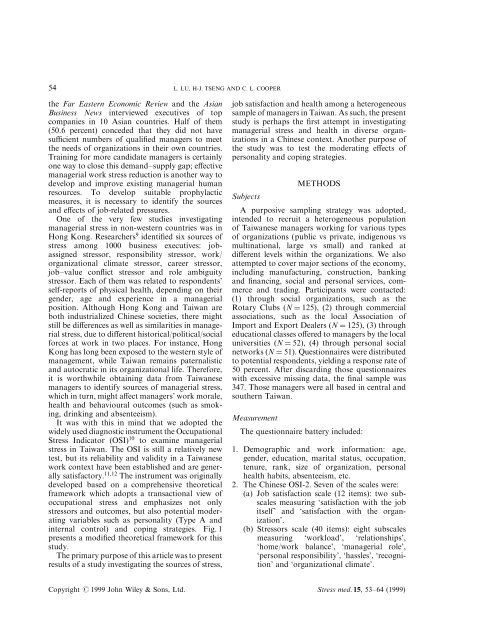Managerial stress, job satisfaction and health in Taiwan
Managerial stress, job satisfaction and health in Taiwan
Managerial stress, job satisfaction and health in Taiwan
You also want an ePaper? Increase the reach of your titles
YUMPU automatically turns print PDFs into web optimized ePapers that Google loves.
54 L. LU, H-J. TSENG AND C. L. COOPERthe Far Eastern Economic Review <strong>and</strong> the AsianBus<strong>in</strong>ess News <strong>in</strong>terviewed executives of topcompanies <strong>in</strong> 10 Asian countries. Half of them(50.6 percent) conceded that they did not havesucient numbers of quali®ed managers to meetthe needs of organizations <strong>in</strong> their own countries.Tra<strong>in</strong><strong>in</strong>g for more c<strong>and</strong>idate managers is certa<strong>in</strong>lyone way to close this dem<strong>and</strong>±supply gap; e€ectivemanagerial work <strong>stress</strong> reduction is another way todevelop <strong>and</strong> improve exist<strong>in</strong>g managerial humanresources. To develop suitable prophylacticmeasures, it is necessary to identify the sources<strong>and</strong> e€ects of <strong>job</strong>-related pressures.One of the very few studies <strong>in</strong>vestigat<strong>in</strong>gmanagerial <strong>stress</strong> <strong>in</strong> non-western countries was <strong>in</strong>Hong Kong. Researchers 9 identi®ed six sources of<strong>stress</strong> among 1000 bus<strong>in</strong>ess executives: <strong>job</strong>assigned<strong>stress</strong>or, responsibility <strong>stress</strong>or, work/organizational climate <strong>stress</strong>or, career <strong>stress</strong>or,<strong>job</strong>±value con¯ict <strong>stress</strong>or <strong>and</strong> role ambiguity<strong>stress</strong>or. Each of them was related to respondents'self-reports of physical <strong>health</strong>, depend<strong>in</strong>g on theirgender, age <strong>and</strong> experience <strong>in</strong> a managerialposition. Although Hong Kong <strong>and</strong> <strong>Taiwan</strong> areboth <strong>in</strong>dustrialized Ch<strong>in</strong>ese societies, there mightstill be di€erences as well as similarities <strong>in</strong> managerial<strong>stress</strong>, due to di€erent historical/political/socialforces at work <strong>in</strong> two places. For <strong>in</strong>stance, HongKong has long been exposed to the western style ofmanagement, while <strong>Taiwan</strong> rema<strong>in</strong>s paternalistic<strong>and</strong> autocratic <strong>in</strong> its organizational life. Therefore,it is worthwhile obta<strong>in</strong><strong>in</strong>g data from <strong>Taiwan</strong>esemanagers to identify sources of managerial <strong>stress</strong>,which <strong>in</strong> turn, might a€ect managers' work morale,<strong>health</strong> <strong>and</strong> behavioural outcomes (such as smok<strong>in</strong>g,dr<strong>in</strong>k<strong>in</strong>g <strong>and</strong> absenteeism).It was with this <strong>in</strong> m<strong>in</strong>d that we adopted thewidely used diagnostic <strong>in</strong>strument the OccupationalStress Indicator (OSI) 10 to exam<strong>in</strong>e managerial<strong>stress</strong> <strong>in</strong> <strong>Taiwan</strong>. The OSI is still a relatively newtest, but its reliability <strong>and</strong> validity <strong>in</strong> a <strong>Taiwan</strong>esework context have been established <strong>and</strong> are generallysatisfactory. 11,12 The <strong>in</strong>strument was orig<strong>in</strong>allydeveloped based on a comprehensive theoreticalframework which adopts a transactional view ofoccupational <strong>stress</strong> <strong>and</strong> emphasizes not only<strong>stress</strong>ors <strong>and</strong> outcomes, but also potential moderat<strong>in</strong>gvariables such as personality (Type A <strong>and</strong><strong>in</strong>ternal control) <strong>and</strong> cop<strong>in</strong>g strategies. Fig. 1presents a modi®ed theoretical framework for thisstudy.The primary purpose of this article was to presentresults of a study <strong>in</strong>vestigat<strong>in</strong>g the sources of <strong>stress</strong>,<strong>job</strong> <strong>satisfaction</strong> <strong>and</strong> <strong>health</strong> among a heterogeneoussample of managers <strong>in</strong> <strong>Taiwan</strong>. As such, the presentstudy is perhaps the ®rst attempt <strong>in</strong> <strong>in</strong>vestigat<strong>in</strong>gmanagerial <strong>stress</strong> <strong>and</strong> <strong>health</strong> <strong>in</strong> diverse organizations<strong>in</strong> a Ch<strong>in</strong>ese context. Another purpose ofthe study was to test the moderat<strong>in</strong>g e€ects ofpersonality <strong>and</strong> cop<strong>in</strong>g strategies.METHODSSubjectsA purposive sampl<strong>in</strong>g strategy was adopted,<strong>in</strong>tended to recruit a heterogeneous populationof <strong>Taiwan</strong>ese managers work<strong>in</strong>g for various typesof organizations (public vs private, <strong>in</strong>digenous vsmult<strong>in</strong>ational, large vs small) <strong>and</strong> ranked atdi€erent levels with<strong>in</strong> the organizations. We alsoattempted to cover major sections of the economy,<strong>in</strong>clud<strong>in</strong>g manufactur<strong>in</strong>g, construction, bank<strong>in</strong>g<strong>and</strong> ®nanc<strong>in</strong>g, social <strong>and</strong> personal services, commerce<strong>and</strong> trad<strong>in</strong>g. Participants were contacted:(1) through social organizations, such as theRotary Clubs (N ˆ 125), (2) through commercialassociations, such as the local Association ofImport <strong>and</strong> Export Dealers (N ˆ 125), (3) througheducational classes o€ered to managers by the localuniversities (N ˆ 52), (4) through personal socialnetworks (N ˆ 51). Questionnaires were distributedto potential respondents, yield<strong>in</strong>g a response rate of50 percent. After discard<strong>in</strong>g those questionnaireswith excessive miss<strong>in</strong>g data, the ®nal sample was347. Those managers were all based <strong>in</strong> central <strong>and</strong>southern <strong>Taiwan</strong>.MeasurementThe questionnaire battery <strong>in</strong>cluded:1. Demographic <strong>and</strong> work <strong>in</strong>formation: age,gender, education, marital status, occupation,tenure, rank, size of organization, personal<strong>health</strong> habits, absenteeism, etc.2. The Ch<strong>in</strong>ese OSI-2. Seven of the scales were:(a) Job <strong>satisfaction</strong> scale (12 items): two subscalesmeasur<strong>in</strong>g `<strong>satisfaction</strong> with the <strong>job</strong>itself' <strong>and</strong> `<strong>satisfaction</strong> with the organization'.(b) Stressors scale (40 items): eight subscalesmeasur<strong>in</strong>g `workload', `relationships',`home/work balance', `managerial role',`personal responsibility', `hassles', `recognition'<strong>and</strong> `organizational climate'.Copyright # 1999 John Wiley & Sons, Ltd. Stress med. 15, 53±64 (1999)
















